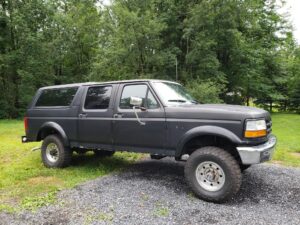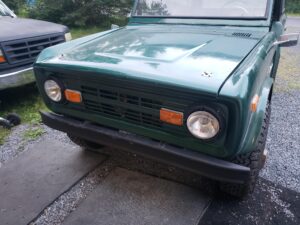How to Maintain and Repair the Brake System of a Classic Ford Bronco

Introduction
The brake system is one of the most important components of any vehicle, especially in a classic like the Ford Bronco. Keeping it in top condition is critical to ensuring safety and optimal performance. This article covers key points for inspecting, maintaining, and repairing the brake system on a Ford Bronco manufactured between 1980 and 1990.
1. Key Components of the Brake System
The Ford Bronco’s brake system consists of the following main components:
- Front Disc Brakes:
- Rotors.
- Brake Pads.
- Calipers.
- Rear Drum Brakes:
- Drums.
- Brake Shoes.
- Wheel Cylinders.
- Hydraulic System:
- Master Cylinder.
- Brake Lines and Hoses.
- Brake Fluid (DOT 3 recommended).
- Emergency Brakes:
- Parking Brake Cables.
- Emergency Brake Lever.
2. Signs of Brake System Problems
Identifying and addressing brake issues early is essential for safety. Here are common signs to look out for:
- Noises While Braking:
- Cause: Worn brake pads or damaged rotors.
- Solution: Inspect and replace pads and/or resurface rotors.
- Spongy Brake Pedal:
- Cause: Air in the hydraulic lines.
- Solution: Bleed the brake system to remove air.
- Brakes Not Responding:
- Cause: Brake fluid leaks or faulty master cylinder.
- Solution: Repair leaks and replace the master cylinder if needed.
- Vibration While Braking:
- Cause: Warped rotors.
- Solution: Replace or resurface rotors.
3. Preventive Maintenance
Regular brake system maintenance ensures proper functionality and extends the lifespan of its components. Follow these steps:
- Inspect Brake Pads and Shoes:
- Check the thickness of the brake pads every 10,000 miles (16,000 kilometers).
- Replace them if they are less than 3 mm thick.
- Check Brake Fluid:
- Inspect the fluid level and quality every 6 months.
- Replace it every 2 years or 30,000 miles (48,000 kilometers).
- Clean Components:
- Clean brake calipers and drums to remove dust and dirt.
- Inspect Brake Lines:
- Check hoses and lines for potential leaks or visible damage.
4. Brake Replacement Process
Here’s a quick guide to replacing front disc brakes:
- Required Tools:
- Torque wrench.
- Brake piston compressor tool.
- Socket wrench set.
- Hydraulic jack and stands.
- Steps:
- Raise the vehicle and secure the rear wheels with wheel chocks.
- Remove the wheel to access the brake assembly.
- Dismount the caliper and remove worn brake pads.
- Clean the rotors with brake cleaner.
- Install new brake pads and remount the caliper.
- Repeat the process for the other wheel and check the brake fluid level.
5. Recommended Replacement Parts
Here are some common part numbers for the Ford Bronco’s brake system:
- Front Brake Pads (OEM): BP12A.
- Front Brake Rotors: DR3237.
- Rear Wheel Cylinders: WC1673.
- Rear Drum Adjustment Kit: ABK2014.
- Master Cylinder: MC1123.
- DOT 3 Brake Fluid: FB003.
6. Tools and Additional Tips
- Use a torque wrench to tighten mounting bolts to the proper specifications (approximately 70-90 ft-lbs for rotor mounting).
- Always perform a road test after completing any brake repairs to ensure proper functionality.
- Keep a brake bleeding kit handy to remove air from the system after repairs.
Conclusion
Maintaining and repairing the brake system is essential for any Ford Bronco classic owner. With the right parts and knowledge, you can ensure your vehicle runs safely and reliably for many years to come.



